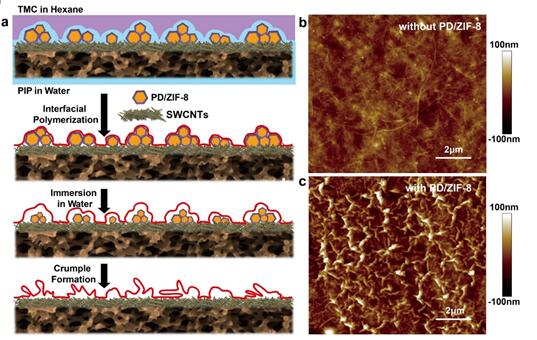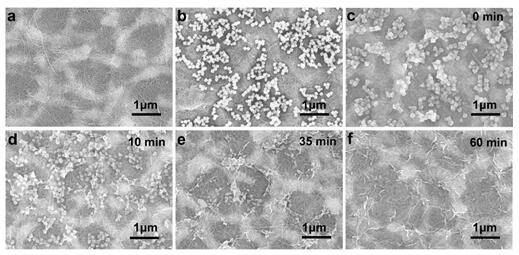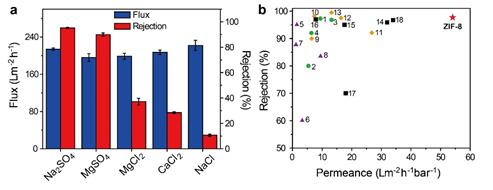Nanofiltration (NF) membrane is a type of pressure-driven membrane with properties in between reverse osmosis and ultrafiltration. Typically, nanofiltration membrane offers the advantage of rejecting multivalent salts and organic molecules with molecular weight cut-off (MWCO) > 200 Da under relatively low operating pressure, rendering Nanofiltration (NF) an ideal water treatment technology for low-energy, high-throughput desalination applications in which ultra-high rejection of monovalent ions is not required. Thus, NF membranes have been widely used in treating industrial process streams, decontaminating wastewater, decoloring and softening brackish groundwater. State-of-the-art NF membranes are based on a thin film composite (TFC) design, where a polyamide (PA) active layer is formed by interfacial polymerization on top of an ultrafiltration membrane. Although significant efforts has been made over the past decades to improve the performance of TFC NF membrane, current permeance of TFC NF membranes is still not high. Enhancing the permeance while maintaining a high solute rejection rate can significantly reduce the membrane area required or lower the operating pressure to achieve a target water production rate, thereby reducing the capital cost and rendering it more affordable. Improving water permeance while maintaining the high rejection of NF membranes remains a great challenge.
The research group led by Prof. JIN Jian at Suzhou Institute of Nano-tech and Nano-Bionics, Chinese Academy of Sciences, presented a novel strategy to design sacrificial nanoparticles-templated PA NF membranes with unprecedentedly high permeance and a satisfactorily high rejection for desalination. The result is published in Nature Communications (https://www.nature.com/articles/s41467-018-04467-3). Based on their previous work (Small, 2016, 12, 5034-5041), in which single-walled carbon nanotube (SWCNT) network acted as an interlayer, researchers deposited ZIF-8 nanoparticles onto the SWCNTs/PES support. These preloaded nanoparticles created rough and irregular nanostructure on the surface of support membrane. Interfacial polymerization of piperazine and trimesoyl chloride occured over such a rugged surface with nanoscale roughness. After polymerization, these nanoparticles were removed by water dissolution, forming a thin PA active layer with extensive crumpled nanoscale structures. The resulting PA TFC membrane exhibited an unprecedentedly high permeance up to 53 L m-2 h-1 bar-1 while maintaining a high rejection of 95 % for Na2SO4. It is by far the most permeable TFC PA NF membrane with a satisfactory level of rejection for NF applications.
The geometric structure of ZIF-8 nanoparticles provides a rough surface structure on support layer and dominates the formation of the crumpled structure. Other soluble nanoparticles, such as ZIF-67 and calcium carbonate (CaCO3) could also be used as sacrificial template to play the same role as ZIF-8 nanoparticles. The NF membrane, with ultrahigh permeance and reasonably high salt rejection, has great potential in advancing brackish groundwater desalination, water softening, household RO/NF, and wastewater reuse.
This work was supported by the National Natural Science Funds for Distinguished Young Scholar (51625306), the Key Project of National Natural Science Foundation of China (21433021), Joint Research Fund for Overseas Chinese, Hong Kong and Macao Scholars (21728602) and the National Natural Science Foundation of China (51603229).

Fig 1. (a) Schematic illustration of evolution process of PA NF membrane with crumpled structures. AFM images of PA NF membranes prepared from SWCNTs/PES composite membrane (b) without and (c) with PD/ZIF-8 loading.(Image by SINANO)

Fig 2. SEM images of (a) pristine SWCNTs/PES composite membrane and (b) PD/ZIF-8 nanoparticles loaded SWCNTs/PES composite membrane. (c–f) Morphology change of the membrane immersed into water in different time after interfacial polymerization reaction.(Image by SINANO)

Fig 3. (a) Desalination performance of the PA NF membranes with respect to different salt solutions. (b) Summary of the filtration performance of the state-of-the-art NF membranes reported in literature in consideration of permeance and rejection for Na2SO4.(Image by SINANO)
Contact information:
Prof.JIN Jian, Suzhou Institute of Nano-Tech and Nano-Bionics, Chinese Academy of Sciences
Email: jjin2009@sinano.ac.cn
Reference:
https://www.nature.com/articles/s41467-018-04467-3
https://onlinelibrary.wiley.com/doi/abs/10.1002/smll.201601253

